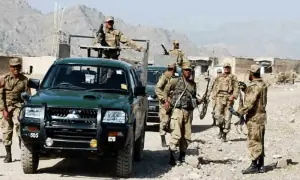The real power and his-story of Malacca cane and the baton of command
When Gen Asim Munir takes command of the Pakistan Army on Tuesday, November 29 (tomorrow) in a grand ceremony to be held at the GHQ in Rawalpindi, he will receive the baton of command from the outgoing chief of army staff, General Qamar Javed Bajwa. Made of Malacca cane, this baton symbolizes the immense power that the head of Pakistan’s land forces wields in country of 220 million people.
Notwithstanding Pakistan’s political context, the baton of command has always represented power for centuries. It was always part of the life of kings and military commanders – hence part of his-story.
The history of the command stick
In the ancient world, warriors carried a weapon known as a “mace” – a blunt and heavy object that would fell an opponent with a single blow.
Usually, only the bravest had the energy to wield this weapon given its enormous weight. That braveheart would also command other warriors. He was the military chief — de facto as there was no question of de jure back then.
What did this blunt weapon look like? That is an interesting question because you and your western friend would imagine it differently.
For many South Asians, including Pakistanis, this weapon — known as “Gorz” in Urdu and Persian and “Gadha” in Hindi — has the shape of a spherical head mounted on a shaft.
In the west, however, the mace was “a type of club or virge that uses a heavy head on the end of a handle to deliver powerful strikes,” according to a Wikipedia entry. In other words, a heavy metal object was attached to one end of a shaft while the other end was formed into a handle.
This western mace appeared closer to a stick or baton.

When the world evolved and humanity invented more weapons to kill and maim others with greater ease, you did not need bodily force to win a war. The mace lost its physical value but its symbolism persisted.
If you go by one account written by Danish author E.O.A. Hedegaard, in this world between the 14th and 16th centuries, Sergeant-at-Arms were tasked with carrying the mace – with the heavy metal end still attached to it.
A few centuries down the road, the heavy metal object was removed and only the shaft was left. Now military commanders could carry it with ease. This was the baton of command as we know it today.
Baton of command in Pakistan
Whenever there is a change of command in a military, the outgoing commander passes the baton to his or her successor. This happens especially in the land forces in Pakistan, India, and Sri Lanka — countries that uphold western military traditions.
Incidentally, the Pakistan Air Force uses a different object to symbolize the change of command: the outgoing chief hands over a sword to his successor. In the Pakistan Navy, a traditional scroll represents the command.
Land forces in the Indian subcontinent use Malacca cane to produce the command stick or baton of command. It is named after the Malacca island of Singapore.
When Pervez Musharraf parted with his baton of command in 2008, millions watched the ceremony on their television screens. It was a historic movement. The general whom his supporters had vowed to elect in uniform a million times was leaving the stage. He soon lost his office as the president of Pakistan.

General Ashfaq Pervaiz Kayani, who took over from Musharraf, continued as the chief of army staff for six years. His successor General Raheel Sharif got only three years.
General Qamar Javed Bajwa served for six years after Imran Khan extended his three-year term in 2019.
When the COAS should not carry the baton stick
Military tradition dictates that army commanders must carry the baton of command at certain occasions, especially when saluting the national flag, receiving the guard of honour or inspecting a parade.
However, the command stick must be kept away when the COAS meets the president or prime minister.

Other than the COAS, the corps commanders and general officers commanding (GOCs) carry the baton of command.
The Pakistani nation is so obsessed with this stick that in 2013 when Bajwa took over one of the most asked questions was, “what if the baton is broken?”
Given the history of Pakistan, one can say that the country has a ready supply of Malacca canes.
For the latest news, follow us on Twitter @Aaj_Urdu. We are also on Facebook, Instagram and YouTube.















Comments are closed on this story.